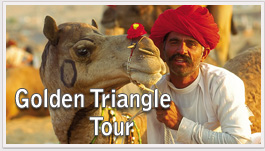Rajasthan Wildlife Tour
The Rbesus macaque and common langur are found throughout Rajasthan with the exception o the arid Thar desert. Monkeys are unharmed by people because of religious sentiments, resulting in their bold behaviour, especially near towns and villages where they snatch food and offerings from unwary pilgrims. The langur feeds on wild leaves and fruit. A wasteful feeder, it drops large quantities on the ground where it is consumed by deer and wild boar which often move with the langur. The langur sounds the alarm to announce the presence of large predators like the tiger or leopard to warn their prey.
The state provides shelter to around 500 species of birds, some of which are rare and endangered. About 50 per cent of these species are local and the balance migratory, mostly from eastern Europe, northern Asia and Africa. It is easy to spot as many as 100 species of birds in just a day in Bharatpur.
 Te Sarus is a handsome crane and the tallest bird in the world to fly. The state’s only resident crane, it is commonly found in its eastern and southern parts. Sarus cranes usually live in pairs or small family groups, but congregate in large groups in the summer months before the onslaught of the monsoons. Even popular legend acknowledges that these birds pair for life, the partner pining away on the death of one. They indulge in an elaborate courtship dance and nest in shallow waters using a heap of grass and reeds. Both partners incubate the eggs. Partners sometimes greet each other while exchanging incubation duties at the nest and perform their courtship dance accompanied with trumpeting.
Te Sarus is a handsome crane and the tallest bird in the world to fly. The state’s only resident crane, it is commonly found in its eastern and southern parts. Sarus cranes usually live in pairs or small family groups, but congregate in large groups in the summer months before the onslaught of the monsoons. Even popular legend acknowledges that these birds pair for life, the partner pining away on the death of one. They indulge in an elaborate courtship dance and nest in shallow waters using a heap of grass and reeds. Both partners incubate the eggs. Partners sometimes greet each other while exchanging incubation duties at the nest and perform their courtship dance accompanied with trumpeting.
The majesti great Indian bustard or godawan is the state bird and is a protected species. Easily spotted in many areas in the desert region, the Desert national park near Jaisalmer is a good area to look for it and, during winter, for the migratory Hubara bustard. The lesser florican too is becoming scare in Rajasthan, though a few birds can be spotted during their breeding season (monsoon) in the fields nearNasirabad and Kishangarh, in the district of Ajmer. Because peacocks are considered sacred by Hindus, they are quite common in the forests, fields and villages of the state. In the Kumbhalgarh and Mt Abu wildlife sanctuaries, the graceful grey jungle fowl is to be found in its northern most limit o distribution in India.
The wetlands and waterbodies of Rajasthan provide refuge to a large number of migratory and resident birds. These include ducks, cranes, pelicans, storks, herons, jacanas, ibises and other aquatic birds. The migratory birds are accomopanied by a number o predatory birds. The Siberian crane is the rarest bird that comes to Bharatpur: its numbers have dwindled from over 40 to a mere three birds in less than 20 years, probably because it is hunted on its migration route over Pakistan and Afghanistan. Attempts to induct captive-bred birds in the wild have not succeeded. Common cranes visit Rajasthan in winter and can be observed at the Keoladeo national park. Demoiselle cranes visit western Rajasthan in large numbers.![]()
Rajasthan Wildlife Tour Package
Duration : 07 Nights / 08 Days
Destination Covered : Delhi-Agra- Bharatpur-Ranthambore-Sariska-Delhi
This Comprehensive Golden Triangle Tour In India Gives You The Beak Through To Have Rendezvous With The Most Eminent Centres Of Indian Culture And Tradition. Apart From Having Entertaining Holidays In Agra, You Are To Travel To Jaipur And Can Also Enjoy The Tourist Attractions Of Delhi. Wildlife Tour Package
Day 01 Arr. Delhi
Upon Arrival In Delhi, Our Executive Will Meet You At The Airport/Railway Station Followed By Transfer From To Hotel.
Day 02 : Delhi
Morning Sightseeing Of New Delhi Where You Visit The Mighty Qutub Minar, The Unique Lotus Shaped Bahai Temple, Humayuns Tomb, India Gate And Sikh Temple At Bangla Sahib. Afternoon Visit Old Delhi With Visit To Raj Ghat : The Mausoleum Of Mahatma Gandhi Followed By Visit To Mughal Monuments Of Red Fort And Jama Masjid.
Day 03 Delhi - Agra ( 204 Kms /4 Hrs)
Morning Departure For Agra. After Arrival Check In At The The Hotel. Afternoon Visit Sikendra And Visit The Taj Mahal, Regarded As One Of The Wonders Of The World, Built By Emperor Shahjahan In Pure White Marble In Memory Of His Beloved Mumtaz Mahal. Then Visit The Massive Agra Fort, Which Has Been The Seat Of Mughal Rulers For Several Years. The Fort Has Palaces With Pavilions, Gardens, Mosques, Baths Etc.
Day 04 Agra - Bharatpur ( 62 Km / 2 Hrs)
Morning Drive To Bharatpur. Stop Enroute Visit Fatehpur Sikri, A City Built In Red Sandstone By Emperor Akbar To Commemorate The Birth Of His Son. Then Proceed Drive To Bharatpur And Check-In To Hotel. Afternoon Visit The World Famous Keoladeo Wildlife Sanctuary Known For Colorful Kingfishers, Graceful Pelicans And Around 375 Species Of Birds. Overnight Stay At The Hotel.
Day 05 Bharatpur - Ranthambore 302 Km / 05 Hrs
Morning Leave For Ranthambore, The Remnants Of Marvelous Architectural Monuments, Ponds And Famous Tiger Reserve. Arrive Ranthambore And Check-In To Hotel. Late Afternoon Drive To The National Park Known For A Variety Of Fauna, Like Famous Tigers, Chital, Nilgai, Jackals, Panthers, Jungle Cats Etc. And Wide Selection Of Birds.
Day 06 Ranthambore - Sariska 240 Km / 04 Hrs
Early In The Morning, You Drive Again To The Ranthambore National Park To Observe Animals In A Different Time Frame. Afternoon Drive To Sariska National Park And Check-In To Hotel.
Day 07 Sariska - Delhi 185 Km / 04 Hrs![]()
Early Morning Safari Into The Sariska National Park, Where You Observe A Variety Of Fauna Similar To Ranthambore, But With An Altogether Different Natural Setting. Then Proceed To Delhi. On Arrival Check In At The Hotel In Delhi.
Day 08 Dep. Delhi
Transfer To International Airport To Connect Flight Back Home.
A Unit Of Rajasthan Travels Pvt
G-23, C-Scheme, Jaipur, Rajasthan -302001
Telephone: +91-9509025926

